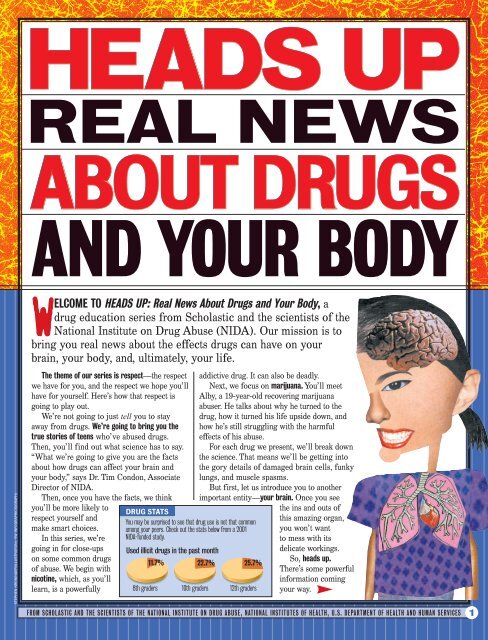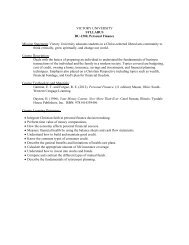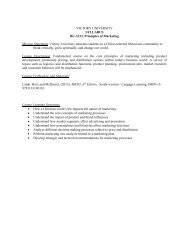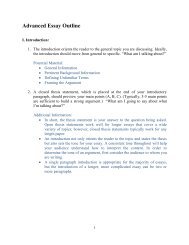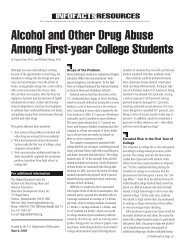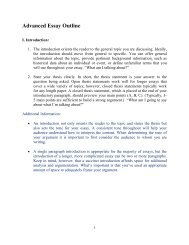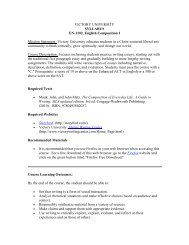Heads Up: Real News About Drugs and Your Body - Scholastic
Heads Up: Real News About Drugs and Your Body - Scholastic
Heads Up: Real News About Drugs and Your Body - Scholastic
Create successful ePaper yourself
Turn your PDF publications into a flip-book with our unique Google optimized e-Paper software.
STEPHEN KRONINGER(ILLUSTRATION); 5W INFOGRAPHICS(GRAPH)WELCOME TO HEADS UP: <strong>Real</strong> <strong>News</strong> <strong>About</strong> <strong>Drugs</strong> <strong>and</strong> <strong>Your</strong> <strong>Body</strong>, adrug education series from <strong>Scholastic</strong> <strong>and</strong> the scientists of theNational Institute on Drug Abuse (NIDA). Our mission is tobring you real news about the effects drugs can have on yourbrain, your body, <strong>and</strong>, ultimately, your life.The theme of our series is respect—the respectwe have for you, <strong>and</strong> the respect we hope you’llhave for yourself. Here’s how that respect isgoing to play out.We’re not going to just tell you to stayaway from drugs. We’re going to bring you thetrue stories of teens who’ve abused drugs.Then, you’ll find out what science has to say.“What we’re going to give you are the factsabout how drugs can affect your brain <strong>and</strong>your body,” says Dr. Tim Condon, AssociateDirector of NIDA.Then, once you have the facts, we thinkyou’ll be more likely torespect yourself <strong>and</strong>make smart choices.In this series, we’regoing in for close-upson some common drugsof abuse. We begin withnicotine, which, as you’lllearn, is a powerfullyDRUG STATSYou may be surprised to see that drug use is not that commonamong your peers. Check out the stats below from a 2001NIDA-funded study.Used illicit drugs in the past month11.7% 22.7% 25.7%8th graders 10th graders 12th gradersaddictive drug. It can also be deadly.Next, we focus on marijuana. You’ll meetAlby, a 19-year-old recovering marijuanaabuser. He talks about why he turned to thedrug, how it turned his life upside down, <strong>and</strong>how he’s still struggling with the harmfuleffects of his abuse.For each drug we present, we’ll break downthe science. That means we’ll be getting intothe gory details of damaged brain cells, funkylungs, <strong>and</strong> muscle spasms.But first, let us introduce you to anotherimportant entity—your brain. Once you seethe ins <strong>and</strong> outs ofthis amazing organ,you won’t wantto mess with itsdelicate workings.So, heads up.There’s some powerfulinformation comingyour way.FROM SCHOLASTIC AND THE SCIENTISTS OF THE NATIONAL INSTITUTE ON DRUG ABUSE, NATIONAL INSTITUTES OF HEALTH, U.S. DEPARTMENT OF HEALTH AND HUMAN SERVICES 1
By Kathy KukulaMeet <strong>Your</strong> Incredible BrainCheck out comm<strong>and</strong> central for everything you do.What’s that gray, wrinkledblob inside your skull? It’s your brain—the body’s most amazing organ, a threepound factory for feelings, memories,ideas, <strong>and</strong> movement. It makes your heartbeat, stores the beat to your favorite song,<strong>and</strong> prompts you to “beat it” whenyou sense danger. <strong>Your</strong> muscles may seemsmart when you hit a home runor learn a dance step, butevery instruction comes fromyour brain.<strong>Your</strong> brain is alwayschanging—<strong>and</strong> growing. Newexperiences create newconnections between braincells, adding to a dense web ofbrain tissue. There’s no end towhat you can learn: One braincell, or neuron, can havethous<strong>and</strong>s of connections, orsynapses, with other braincells. Messages zip fromneuron to neuron, carryinginformation to <strong>and</strong> from yourmuscles <strong>and</strong> sense organs, <strong>and</strong>from brain part to brain part.In short, the brain is anintricate machine. Check outwhat goes on inside your head.YOUR BRAIN: PIECE BY PIECEIN CHARGE: The cerebral cortex is thelargest part of your brain. It sits like amushroom cap on the rest of your brain <strong>and</strong>takes up about two thirds of the total mass.This is where you think <strong>and</strong> reason. It’swhere you create the kind of movementsyou have to think about, like playing thepiano or flipping your skateboard. Parts ofthe cerebral cortex also control seeing,hearing, <strong>and</strong> touching.Plan <strong>and</strong> Reason: The prefrontalcortex helps you plan ahead.This is where you consider theconsequences of your actions. Thispart of your brain doesn’t finishdeveloping until you’re 20.Move: When you think aboutmoving your body, the motorcortex tells your muscles what todo. Precise moves, like typing, orplaying an instrument, use lots ofbrain cells.Sense: The posteriorparietal cortex is aprocessing centerthat makes sense ofwhat you’re feeling,smelling, <strong>and</strong> hearing,<strong>and</strong> connects thosesensations tomemories <strong>and</strong> ideas.THE FEELINGS BRIDGE:The limbic system is like a bridgebetween your thinking brain—the cerebral cortex—<strong>and</strong> theparts of your brain that controlyour body’s physical systems.This makes it easy for strongfeelings—such as pleasure, fear,or attraction to other people—to cause reactions in your stomach,muscles, <strong>and</strong> heart.Remember: The hippocampus, which ispart of the limbic system, receives <strong>and</strong>stores long-term memories. So, if youremember your teachers’ names fromlast year, you’re using the hippocampus.THE BASICS:<strong>Your</strong> brain stemis the lowest partof your brain, just above your spinalcord. This structure takes care ofbasic functions such as the heartbeat,breathing, <strong>and</strong> digestion.IT’S A HABIT:The cerebellumhelps witheveryday tasksyou do over <strong>and</strong>over. Once you’velearned how, you don’treally have to think abouthow to ride a bike, dribblea basketball, or comb yourhair. There’s constantmessaging between thecerebellum <strong>and</strong> parts of the cerebralcortex, so you can adjust youractions when conditions change.5W INFOGRAPHICS2FROM SCHOLASTIC AND THE SCIENTISTS OF THE NATIONAL INSTITUTE ON DRUG ABUSE, NATIONAL INSTITUTES OF HEALTH, U.S. DEPARTMENT OF HEALTH AND HUMAN SERVICES
STEPHEN KRONINGER(ILLUSTRATIONS 2); DIMITRI LUNDT/CORBIS(BASKETBALL); 5W INFOGRAPHICS(DIAGRAM)Instant Messages—IMs in <strong>Your</strong> BrainHow do brain cells get their messages across? Messages travel through brain cells,also called nerve cells or neurons, as electricity. Neurons have threadlike fiberscalled axons that send messages <strong>and</strong> branches called dendrites that receive them.To make messages jump from cell to cell—whenyour brain signals your h<strong>and</strong> to scratch yourhead, for example—your brain creates chemicalscalled neurotransmitters. Whenever you think oract, axons release these chemicals. Dendriteshave receptors, like custom-made garages, intowhich each chemical fits. A fatty white coatingcalled myelin covers many axons; it helpsmessages move quickly, especially along the longaxons that connect to muscles.The Pleasure CenterIf you’ve ever sunk a basket, held h<strong>and</strong>s with someone special, or bitten into a juicycheeseburger, you may remember the rush of pleasurable feelings those eventscreated. These good feelings are a key to your survival—after all, if you eat well,you’ll live longer, <strong>and</strong> most of us think of eating as a pleasurable experience.Unlike remembering, say, your history homework, you remember pleasure morequickly because of a chemical calleddopamine. Dopamine works in thepleasure center in the middle ofyour brain (see the limbic system on thediagram at left).Once you’ve had a “feel-good”experience, your brain builds a newpath, like a shortcut. That’s why you’llstart to feel good the next time you justpick up a basketball, smell thecheeseburger, or see your crush in thehall. <strong>Your</strong> senses send signals, <strong>and</strong> thedopamine starts flowing. You’ve wiredyour brain to repeat what brings goodfeelings. You smile just thinking about it!<strong>Drugs</strong> Fool <strong>Your</strong> BrainDifferent drugs act on the brain in different ways. But all drugs of abuse have onething in common: they act on the way the brain experiences pleasure. <strong>Drugs</strong>make people “high” by invading <strong>and</strong> manipulating the brain’s pleasure circuitry.They fool your brain into good feelings that are a reaction to chemicals, instead of toreal experiences.The key word is “fool.” Drug abuse can damage the brain’s wiring for pleasure,making it unable to function in a healthy, normal way. You can become addicted, meaningthat your craving for the feeling you get from a drug will become so strong that you’llrisk serious consequences to get it. And your ability to feel pleasure the old-fashionedway—the real way—may be disrupted. Good food, real accomplishments—even truelove—may leave you feeling flat.In addition to damaging the way you process pleasure, drugs can damage your brain<strong>and</strong> body in many other ways. So don’t be fooled. And keep reading to learn more.AMAZING FACTS• When you’re born, yourbrain weighs about a pound.But by age six, itweighs three pounds.What happens? Learning tost<strong>and</strong>, talk, <strong>and</strong> walkcreates a web ofconnections in yourhead—two pounds worth!• <strong>Your</strong> brain weight accounts for about two percent of yourbody weight. But your brain uses 20 percent of your body’soxygen supply <strong>and</strong> 20 to 30 percent of your body’s energy.• <strong>Your</strong> brain has about 100 billion neurons. A typicalbrain cell has from 1,000 to 10,000 connections to otherbrain cells.• The right side of your brain controls the left side of yourbody, <strong>and</strong> the left side of your brain controls the rightside of your body.• <strong>Your</strong> brain is full of nerve cells, but it has no painreceptors. Doctors can operate on your brain whileyou’re awake—<strong>and</strong> you won’t feel a thing!• A message for actiontravels from your brainto your muscles as fastas 250 miles per hour.• If you ironed out all thewrinkles in your brain, itwould have an area ofabout two <strong>and</strong> ahalf square feet.It feels likesoft butter.FROM SCHOLASTIC AND THE SCIENTISTS OF THE NATIONAL INSTITUTE ON DRUG ABUSE, NATIONAL INSTITUTES OF HEALTH, U.S. DEPARTMENT OF HEALTH AND HUMAN SERVICES 3
SODASmoking GunCigarettes are addictive <strong>and</strong> deadly. So why are teens still smoking?CLOSE UP: NICOTINEBy John DiConsiglioIf you’re looking for the RobinsonRams baseball team during fourth period lunch,don’t bother searching the cafeteria or thepractice diamond. On most afternoons, you’llfind a h<strong>and</strong>ful of the top players from RobinsonSecondary School in Fairfax,VA, huddled in a friend’snearby basement. They eatpizza. They play Tony Hawkvideo games. And always—Kevin McNamara, 18SMOKER/TRYING TO QUITalways—they smoke cigarettes.“Kids hanging out. Whetherit’s a party or lunch, there aregoing to be smokes,” says KevinMcNamara, an 18-year-oldRobinson senior <strong>and</strong> a regularattendee at the basement brunch.Kevin is a star member of theschool’s golf team. He was alsothe Rams’ ace pitcher until hetore a ligament in his knee.And, until recently, hesmoked two packs a day.“Kevin’s story is not unusual,”says Dr. Bill Corrigall, Directorof NIDA’s Nicotine <strong>and</strong> TobaccoAddiction Program. “Many teens<strong>and</strong> even pre-teens begin toexperiment with smoking, butsoon find they are smokingregularly—they’re addicted.”“I WANT TO QUIT”“I used to be able to run a milein under six minutes. NowI’m lucky to make it in eight.And I’m wheezing all theway,” says Kevin, who’s cuthis daily use down to tencigarettes. “I want to quit.But it’s not that easy.”More than ever, teensfind that the best way tostop smoking is to never startat all. Teen smoking rateshave steadily fallen since1996, according to a NIDAfundedstudy.That’s the good news. Thebad news, experts say, is thatteen smoking numbers arestill too high. Each day,more than 3,000 children<strong>and</strong> adolescents becomecigarette smokers, notesthe Centers for DiseaseControl <strong>and</strong> Prevention.That’s more than 1 million teensa year. Roughly one-third ofthem will die from a smokingrelatedillness.“There’s hard evidence thatsmoking leads to addiction,health problems, <strong>and</strong> death,”says Dr. Eric Moolchan, directorof NIDA’s Teen TobaccoAddiction Treatment ResearchClinic. “Teens have a choice:They can become victims, orthey can stop before they go toofar. Better yet, they never have tostart at all.”“I MUST HAVE BEEN CRAZY”Even those who are well awarethat smoking kills findcigarettes hard to resist. SarahMillermon, an 18-year-old fromStockton, CA, knows thedangers of cancer first-h<strong>and</strong>.When she was a baby, shedeveloped leukemia, a bloodrelatedcancer. She underwentchemotherapy until she wastwo. And, while she’s beenSarah Millermon, 18FORMER SMOKER4FROM SCHOLASTIC AND THE SCIENTISTS OF THE NATIONAL INSTITUTE ON DRUG ABUSE, NATIONAL INSTITUTES OF HEALTH, U.S. DEPARTMENT OF HEALTH AND HUMAN SERVICES
JAKUB MOSUR/AP WIDE WORLD PHOTOS(TOBACCO); ANTONIO M. ROSARIO/THE IMAGE BANK BY GETTY IMAGES(CIGARS); AFP/PRAKASH SINGH/CORBIS(BIDIS); 5W INFOGRAPHICS(DIAGRAM); JAMES STEVENSON/S.P.L./PHOTO RESEARCHERS(LUNG)Ashley Sobrinski, 14NON-SMOKERcancer-free ever since, the prospectof a relapse is never far fromher mind.Still, as a teen, Sarah went on tosmoke a pack a day, putting herselfat risk for cancer of the lungs,mouth, esophagus, larynx, stomach,pancreas, kidney, <strong>and</strong> bladder.“When you’re addicted tocigarettes, you can rationalizeanything,” says Sarah, who hasn’tsmoked in three months. “I’d tellmyself: ‘Well, I beat cancer once. Ican do it again.’Now I look back <strong>and</strong>think I must have been crazy.”“A HORRIBLE THING TO SEE”Unlike Sarah, some teens see theravaging effects of cancer <strong>and</strong> vownever to pick up a cigarette. AshleySobrinski, a 14-year-old fromOcean City, NJ, watched hergr<strong>and</strong>father succumb to lung cancer.“It’s a horrible thing to see,”she says. “The cancer just took overhis body.” He began smoking as ateenager in the Navy. Ashleyunderst<strong>and</strong>s how a teen in the 1940smight have been tricked into takingup cigarettes. But she can’t see howtoday’s teens fall for it.“With all the information that’sout there, with all the people whohave died from smoking, it justpuzzles me that kids keep doing it,”she says. “You know that if you putthat cigarette in your mouth, it mightkill you. But you do it anyway. Thatjust doesn’t make sense.”CIGARETTES: HOW THEY HOOK AND HURTCigarette smoke contains more than 4,000chemicals, including toxins like ammonia. Butthe chief culprit in cigarettes is nicotine, apowerfully addictive drug.With every puff of a cigarette, nicotine alters howyour brain functions. Like cocaine <strong>and</strong> heroin, nicotinestimulates the release of a molecule called dopamine,located in parts of the brain that are involved inaddictive behaviors. Although a user does not get thehigh from cigarettes that one might get from drugslike cocaine <strong>and</strong> heroin, make no mistake: nicotineaffects your brain.Nicotine “primes” the brainfor addiction. You can begin tocrave cigarettes more thananything else. “Smokingbecomes your sole focus,” saysBy Any Other NameA post-mortemcancerous lung ofa cigarette smoker.As if cigarettes aren’t bad enough, there areother hazardous tobacco products. Because ofhow they look or smell or how they’re used,some people might think they’re not as addictive orharmful as cigarettes. But here’s the truth:• Chewing tobacco: Spit, snuff, dip, smokeless. Theamount of nicotine in one pinch of dip can be fivetimes as high as in a cigarette. Plus, dip comeswith its own health risks. From the toxins in thejuice created, chewers can develop painful lesionson their tongue, as well as cancer of theesophagus, pharynx, larynx, <strong>and</strong> stomach.Perhaps worst of all are cancers of the mouth<strong>and</strong> tongue, which often require surgery toremove parts of a user’s face. These cancersfrom chewing tobacco often occur earlier, ratherthan later, in a user’s life.• Cigars: Cigars are puffed <strong>and</strong> not inhaled, but thesmoke still gets into the lungs <strong>and</strong> does just asmuch damage as cigarettes, <strong>and</strong> cigar smokersDr. Cindy Miner, the Chief of NIDA’s Science PolicyBranch. “Nothing else is as pleasurable as it usedto be.”Indeed, your brain becomes so used to thepresence of nicotine that, when you try to quit, itrebels <strong>and</strong> craves more.But addiction may be just the tip of the icebergwhen it comes to risks from smoking. When youinhale, cigarette smoke <strong>and</strong> the chemicals it carriesare absorbed by the lungs <strong>and</strong> quickly move into thebloodstream, where they circulate through your heartto your brain <strong>and</strong> the rest of your body.<strong>Your</strong> lungs fill with chemical deposits.“You’re taking tar into your lungs<strong>and</strong> there’s no way to clear out allthat debris,” says Miner. “Suddenlyyou find that you are gasping forbreath on the soccer field.”Research suggests that nicotine is even moreharmful to the developing heart, lungs, <strong>and</strong> brainsof teens. “The younger you start, the more likelyyou will get hooked,” Miner says. “The younger youget hooked, the more cigarettes you will smoke.And the more cigarettes you smoke. . . . Well, weknow where that leads.”risk the same oral cancer <strong>and</strong> other irritationproblems as people who chew tobacco. Also, acigar delivers nicotine. In fact, it delivers aboutfour times as much nicotine as a cigarette.• Bidis: These h<strong>and</strong>-rolled cigarettes from India(pronounced “beedees”) are often packaged incinnamon, orange, <strong>and</strong> chocolate flavors toappeal to kids. But don’t let the taste fool you.Bidis are generally unfiltered <strong>and</strong> can have 28percent higher nicotine concentration levelsthan cigarettes.ChewingTobaccoBidisCigarsFROM SCHOLASTIC AND THE SCIENTISTS OF THE NATIONAL INSTITUTE ON DRUG ABUSE, NATIONAL INSTITUTES OF HEALTH, U.S. DEPARTMENT OF HEALTH AND HUMAN SERVICES 5
The Lows of Getting HighOne teen’s journey from street corner to jail to recoveryCLOSE UP: MARIJUANABy Cate BailyAt 18, Alby Podolski was living anightmare behind bars. He felt he was inconstant physical danger. “I saw people getstabbed,” Alby says. And he experienced dailyindignities. “I couldn’t eat the food they served.The potatoes were like blocks <strong>and</strong> the meatdidn’t taste like meat,” he says.Believe it or not, gettingarrested was probablythe best thing that couldhave happened to Alby. Itgot him into treatment forhis drug problem.When we spoke toAlby, he was one monthinto his recovery at Daytop,a drug rehabilitation centerin Westchester, NY.GRUDGE AGAINSTTHE WORLDIt all started one summer dayon a street corner in Yonkerswhen Alby was 13. “You needto get your mind right. Hit thisblunt,” a friend said.definitely addicted,” says Alby of his dailyuse of marijuana over a five-year period. For some“Iwaspeople, this is a controversial idea.They argue that marijuana is not addictive.According to NIDA, addiction ischaracterized by “compulsive, at timesuncontrollable, drug craving, seeking, <strong>and</strong>use that persist even in the face of extremelynegative consequences.”Dr. Glen Hanson, the Acting Director ofAlby Podolski, 19FORMER MARIJUANA ABUSER / IN TREATMENTAlby didn’t have thestrength to say no. He felt hehad to smoke the blunt (acigar hollowed out <strong>and</strong>THE ADDICTION QUESTIONrefilled with marijuana or amix of cocaine <strong>and</strong> marijuana)to fit in. And he desperatelywanted to belong.His parents had never beenthere for him. They were drugaddicts themselves <strong>and</strong>couldn’t h<strong>and</strong>le the dem<strong>and</strong>sof parenting. So, Alby bouncedfrom a foster home to hisgr<strong>and</strong>mother’s to a grouphome. When he was about 14,his mother died.“I wasn’t supposed togo through this,” Alby says.“I had a grudge againstthe world.”After trying marijuana(also called weed, grass,pot, herb, boom, MaryJane, <strong>and</strong> chronic) to fitin, Alby kept abusing thedrug because he enjoyedthe high, or intoxicatedfeeling, marijuana creates. “Ithad me in another state ofmind,” he says. “I was relaxed.All my problems seemed likethey were disappearing.”NIDA, says that marijuana is indeed addictive. “I find itironic that people say ‘oh, it's not addictive’ <strong>and</strong> yet it’s themost commonly used of our illicit [illegal]drugs,” he says.Although Hanson concedes that not everyonewho smokes marijuana becomes addicted, hepoints out that many people experience cravingsfor the drug <strong>and</strong> have withdrawal symptoms whenthey get off it. “For me, that defines addiction,”he says.ERIC O’CONNELL/TAXI BY GETTY IMAGES(MARIJUANA)6FROM SCHOLASTIC AND THE SCIENTISTS OF THE NATIONAL INSTITUTE ON DRUG ABUSE, NATIONAL INSTITUTES OF HEALTH, U.S. DEPARTMENT OF HEALTH AND HUMAN SERVICES
THC INVASIONThe relaxed feeling Alby describes was caused by THC(tetrahydrocannabinol), the active ingredient (mostpowerful chemical) in marijuana. But the chemical wasalso responsible for the negative effects he experienced.Here’s what happens: When a user smokes marijuana, theTHC travels quickly through the bloodstream to the brain.That’s when the problems start. In everyone’s brain, there arespecial receptors, called cannabinoid receptors. They’re locatedin several important brain regions (shown here in brown),including the area that helps you remember things. THCattaches to thecannabinoid receptors <strong>and</strong>interferes with the brain’snormal functioning.Trying to remember aphone number? Forget it, ifTHC has taken over.BraincellNeurotransmittemittersTHCmoleculeBlockedcannabinoid receptorMENTAL BLOCK: A THC molecule binding to a cannabinoidreceptor <strong>and</strong> suppressing the neuron’s ability to send messagesSTEPHEN KRONINGER(ILLUSTRATION); 5W INFOGRAPHICS(CHART AND DIAGRAMS)THE PRICEBut Alby’s problems weren’tdisappearing. They were gettingworse. The good feelings hesought from marijuana wouldcome at a price.Over the next five years,Alby smoked marijuana everyday, several times a day. Hewent to school high <strong>and</strong>eventually dropped out. “I waslosing focus. My attentionwent from 100 to 0. I wasdepressed,” he says.Despite the consequences,Alby kept smoking marijuana.In fact, he was willing to doanything to get high.Eventually, he started dealingdrugs to support his habit.That’s what l<strong>and</strong>ed him inValhalla Correctional Facility,a maximum-security jailin Westchester.NEW FRIENDS,LINGERING EFFECTSNow, at Daytop, Alby has beenable to address the realproblems in his life by talkingthem out with counselors <strong>and</strong>making new friends whom hedescribes as “positive.”But he still feels some ofthe effects of his drug use.“Sometimes I want to saythings, <strong>and</strong> I can’t get them out.I can’t find the word,” Albysays. “I never had that problembefore I started smoking.”Alby’s memory problemsmay improve with time. But fornow, they are enormously frustrating.“I used to know things,”says Alby. “But now, it’s rusty. Iforgot how to do division.”Frustrations aside, he islooking ahead <strong>and</strong> hoping tocreate a future for himself.Alby wants to pursue a careeras a mechanic.Marijuana: By The NumbersMarijuana may be themost commonly usedillicit drug. But it’s NOTbeing used by most of yourpeers—not even close. In caseyou ever get that classic peerpressure line, “Everyone’sPAST YEAR USE8thgradersdoing it,” here are the real numbers from a 2001 NIDA-funded study.Tobacco Vs. MarijuanaYou’ve read our report about cigarette smoking <strong>and</strong> the damagethat can do to your lungs. But what marijuana does to yourlungs may be news.Here’s some of what science tells us:• Marijuana smokers can develop phlegm <strong>and</strong> a daily cough.• Marijuana smoke contains 50 to 70 percent more cancer-causingchemicals than tobacco smoke.• Puff for puff, smoking marijuana may increase the risk ofcancer more than smoking tobacco does.• People who smoke marijuana are at greater risk for lunginfections, like pneumonia.• Chronic marijuana smokers are vulnerableto bronchitis, emphysema, <strong>and</strong>bronchial asthma.• Scientists have foundsigns of lung tissueinjured or destroyed dueto marijuana use.15.4% 32.7% 37.0%10thgraders12thgradersFROM SCHOLASTIC AND THE SCIENTISTS OF THE NATIONAL INSTITUTE ON DRUG ABUSE, NATIONAL INSTITUTES OF HEALTH, U.S. DEPARTMENT OF HEALTH AND HUMAN SERVICES7
“E” Is for Emptywww.scholastic.com/HEADSUPCLOSE-UP: ECSTASYBy Laura D’AngeloCLOSE-UP:Ecstasy use left Daniel feeling worthless <strong>and</strong> alone.Daniel Oerum, 17, of San Clarita Valley,California, wanted prom night to be special. So,he reached into his tuxedo pocket <strong>and</strong> took outpills stamped with images of Tweety Bird <strong>and</strong>Buddha. Ecstasy (also called E, X, XTC, Adam,hug, love drug, <strong>and</strong> beans) looked harmlessenough. But Daniel found out the hard way howdangerous it can be.“My heart was racing sofast. I thought I was having aheart attack,” Daniel said. Afriend helped him into the prombecause his legs wouldn’t stoptrembling. The dance floor waslocated on a Hollywood movieset. Daniel tingled from head totoe. “Then I hit a peak,” he said.“I felt like a movie star.”Later at a friend’s house,Daniel crashed into gloom<strong>and</strong> confusion. He swallowedtwo more “E” pills. Takingmultiple doses within arelatively short time multipliesthe toxic risks of any drug. Withecstasy, “stacking,” or doublingthe dose, carries especially highrisk. The level of ecstasy builds<strong>and</strong> the user’s body can’t keepup with the amount of drug inhis or her blood. That’s whathappened to Daniel.“I lay down <strong>and</strong> couldn’t liftmy head,” he said. “My legswere rocking back <strong>and</strong> forth.”The following weekend,CASUALTY OF ECSTASYNineteen-year-old Melissa Ross died after trying ecstasy for the first time. The EmoryUniversity sophomore had hoped to dance the night away with friends at an Atlantaclub. Instead, she ended up in the morgue.<strong>News</strong> of her death shocked Bill Gentry, a close friend who remembers singing <strong>and</strong>playing piano with Melissa in their dorm lobby. “Melissa was probably one of the cleanestpeople I’d ever known. She didn’t do drugs, smoke, or even drink. She probably wanted totry ecstasy <strong>and</strong> see what it was like,” he said. “I’m sure if she knew ecstasy could kill, shenever would have taken it.”Melissa died from a fatal heat reaction, known as hyperthermia. Part stimulant, ecstasyacts on the brain’s hypothalamus. It ramps up heart rate <strong>and</strong> blood pressure <strong>and</strong> disruptsthe brain’s ability to regulate body temperature. A brain unable to cool off an overexertedbody on a jam-packed dance floor spells disaster. “The body sweats <strong>and</strong> the extreme loss ofwater causes dehydration,” says Dr. Glen Hanson, Acting Director of the National Instituteon Drug Abuse (NIDA). “Users tend to ignore some of these symptoms, partly because thedrug masks them, <strong>and</strong> partly because they’re distracted by the social setting.”Daniel dropped “E” at arave where some 200 kidsdanced on a dirt clearing.Before long Daniel was sellingecstasy. “I’d walk into raves<strong>and</strong> yell ‘E’ <strong>and</strong> people wouldcrowd around. I felt a sense ofpower.” With the profits, hebought more ecstasy which hetook often, always with otherkids. “I did drugs so I didn’thave to feel alone,” he said.When Daniel’s fatherworked nights, friendsflocked to his house. Adornedwith glow-in-the-dark shirts<strong>and</strong> beads, they danced totrance music <strong>and</strong> chewedpacifiers to keep their teethfrom grinding.LIVES DESTROYEDSoon Daniel was dropping up tofive “E” pills a day. Desperate tofeed his habit, he started sellingFORMEEROWID.ORG(PILLS); GREG SMITH/AP WIDE WORLD PHOTOS(RAVE)8FROM SCHOLASTIC AND THE SCIENTISTS OF THE NATIONAL INSTITUTE ON DRUG ABUSE, NATIONAL INSTITUTES OF HEALTH, U.S. DEPARTMENT OF HEALTH AND HUMAN SERVICES
Daniel Oerum, 17R ECSTASY ABUSER/IN TREATMENTSTEPHEN KRONINGER(ILLUSTRATIONS 2); 5W INFOGRAPHICS(DIAGRAM)cocaine <strong>and</strong> methamphetamineas well as ecstasy. “I was skinny.My skin was the color of paper.My teeth were rotting out,”Daniel said. “I would stealanything I could get my h<strong>and</strong>son. I stole valuables from mydad. I didn’t see anything wrongwith the way I was acting.”Once, a friend’s motherwanted to buy drugs fromDaniel. When he delivered thebag of speed to the house,Daniel watched his friend’sface crumple in sadness. “I feltreally bad. I saw lives beingdestroyed because of what Iwas doing,” he said.On New Year’s Eve,Daniel’s girlfriend called hima “drug addict” <strong>and</strong> a“lowlife.” He jumped out ofher car. “Staring at the cityhotels <strong>and</strong> gas stations, Ithought ‘I’m going to be livingalone in the streets’ <strong>and</strong> thatscared the daylights out ofme,” Daniel recalled.The next morning, he wentto his father <strong>and</strong> said, “Dad, Ineed help.”NEW YEAR/NEW BEGINNINGA resident of Phoenix House, adrug-treatment center in LakeView Terrace, California,Daniel has been clean for sixFAQS ON XTC1 What is it?Ecstasy, or methylenedioxymethamphetamine (MDMA),is part hallucinogen <strong>and</strong> part stimulant.2 How many teens use ecstasy?According to a 2001 NIDA-funded study, 5.2% of 8thgradershad tried ecstasy; 8% of 10th-graders hadtried the drug; <strong>and</strong> 11.7% of 12th-graders.3 How does it make a user feel?In the short term, ecstasy can make someusers feel confident, blissful, <strong>and</strong>uninhibited. Users may also have negativeexperiences, like anxiety attacks.4 What are the side effects?“E” can damage a user’s brain. “Moderateto heavy ecstasy users are likely to havememory <strong>and</strong> sleep problems <strong>and</strong> experiencedepression,” says Dr. Hanson. How doesthat happen? Ecstasy can “x-out” thefibers of neurons that carry serotonin, achemical messenger that plays a big role inmood, pain, sleep, memory, <strong>and</strong> thinking.months. He’s gained weight,<strong>and</strong> he cares about himselfagain. But he worries aboutecstasy’s effects. “I feel likeI’ve suffered brain damage,”he said. “Sometimes I getstuck in conversations, becauseI can’t find a word.” Othertimes he walks the unit <strong>and</strong>stops in horror, forgettingwhere he’s going.Daniel is trying tounderst<strong>and</strong> his past <strong>and</strong> piecehis life back together. “I got intodrugs because I felt like no oneliked me. Then nobody wantedto be around me because ofthe drugs, <strong>and</strong> I ended upcompletely alone,” he said. “Ifeel like a new person now.”a national PBS weekly series for teens<strong>Real</strong> teens talk about ecstasy in anupcoming episode of the awardwinningreality series for teens. Checkyour local PBS listings or inthemix.org5 Do the neuron fibers grow back?Sometimes they do grow back, but not necessarily in thesame parts of the brain. “It’s like cutting off a limb of afruit tree,” says Hanson. “The tree’s still alive <strong>and</strong> cansprout a new limb somewhere else, but it may not bearas much fruit as the old one,” says Hanson.Serotonin Transmissionin the BrainSerotonin travels through the healthy brain by jumping from cell tocell along the fibers of neurons (brain cells). But ecstasy usedamages the terminals (ends) of neuron fibers. Chemicalmessages relating to mood, sleep, memory, <strong>and</strong> more are disrupted.Beware of Club <strong>Drugs</strong>Ecstasy <strong>and</strong> other so-called club drugs emerged from theunderground rave scene. Some produce a sense of detachmentfrom the user’s surroundings or self—or even realunconsciousness. Because of these “dissociative” effects, these drugsare often used in date rapes. All club drugs can cause serious healthconsequences or, in some cases, death. Combining them with alcohol isespecially dangerous.• GHB or Gamma-hydroxybutyrate (aka G, liquid ecstasy,<strong>and</strong> Georgia Home Boy) has euphoric, sedative, <strong>and</strong> anabolic(body building) effects. A liquid or powder with a salty taste,it may be added to spring water or concealed in mouthwash bottles.With flavorings, it can be passed off as a high-carb drink.• Ketamine (aka Special K or K) is a dissociativedrug commonly used as a horse tranquilizer. A powder orliquid, it is snorted, sprinkled onto cigarettes, injected,or hidden in drinks.• Methamphetamine (aka speed, ice, chalk, <strong>and</strong> meth),a stimulant, excites the central nervous system. It isa white, odorless, bitter-tasting crystalline powderthat is snorted or smoked, or dissolved in water oralcohol <strong>and</strong> injected or swallowed.• LSD or Lysergic Acid Diethylamide (aka acid) is ahallucinogen, or drug that causeshallucinations. It may be distributed inbreath-mint vials, treated sugar cubes, gelwafers called “windowpanes,” pills, or decoratedblotter paper that is chewed or swallowed.FROM SCHOLASTIC AND THE SCIENTISTS OF THE NATIONAL INSTITUTE ON DRUG ABUSE, NATIONAL INSTITUTES OF HEALTH, U.S. DEPARTMENT OF HEALTH AND HUMAN SERVICES 9
Pain Meets Poisonwww.scholastic.com/HEADSUPCLOSE-UP: INHALANTSBy Cate BailyThe true story of how one teen huffed herway to rock bottom <strong>and</strong> almost diedUntil she was 12, Megan Hakeman had asimple life in Watertown, South Dakota, a smalltown with one mall <strong>and</strong> one movie theater. Shedescribed herself as a “regular, happy kid” whohung out with friends <strong>and</strong> watched TV. The onlyreal suffering she’d known was losing hergr<strong>and</strong>father, but she said she accepted that as“part of life.”Then, things gotcomplicated. Megan wassexually abused by a trustedfriend.“I thought about it [theattack] a lot <strong>and</strong> I didn’tknow what to do. I wantedit to go away,” she says.Too afraid to tell herparents <strong>and</strong> unsure ofhow else to cope withher feelings, Meg<strong>and</strong>ecided to try toescape her pain. Afriend showed her how to gethigh using inhalants.Inhalants are, to put itsimply, poisons. Most of themare common householdproducts, like spray paints, airfresheners, paint thinner,correction fluid, <strong>and</strong> lighterfluid. All give off toxic fumes.HURTING HERSELFMegan <strong>and</strong> a group offriends began “huffing”together often. They joined the15.2% of their peers who haveexperimented with inhalants bythe time they’re in 8th grade.Megan Hakeman, 16FORMER INHALANT ABUSERBut Megan’s friends soonlearned something terrifying:Huffing can kill you. So, theywisely quit.Despite this scary news,Megan kept huffing alone. Herwhole sense of self-worth wasout of whack after the sexualabuse. “I figured why not hurtmyself, if he [the attacker] hurtme,” she told <strong>Scholastic</strong>.And she was indeed hurtingherself <strong>and</strong> risking manymedical consequences. Dr.David Shurtleff, the ActingDirector of Neuroscience <strong>and</strong>Behavioral Research at NIDA,says that inhalants can affectyour ability to think, talk,remember, hear, <strong>and</strong> evenwalk. “<strong>Real</strong>ly what you’redoing is destroying nerve fibersthroughout the brain,” he says.HURTING MOMIt wasn’t just Megan’s braincells that were in danger. Sheignored her schoolwork.Her best friend dumpedher because of the druguse. And she lashed out ather mom.“I always hit mymom when I was using,”says Megan. “I feel reallybad because I should havenever hit my mom. That’ssomething that nobody shouldever do.”These violent outburstsmay have been an effect of theinhalants. According to Dr.Shurtleff, huffing can causeagitation, irritability, <strong>and</strong> evenviolent behavior.EMBARRASSMENT TOTHE FAMILYMegan hit rock bottom onenight. High on inhalants <strong>and</strong>other drugs, she rode on top ofa friend’s car, fell off, <strong>and</strong> gota concussion.Then, rock bottom got evenlower. The next night, shefought with her brother. Hesaid she was an embarrassment10FROM SCHOLASTIC AND THE SCIENTISTS OF THE NATIONAL INSTITUTE ON DRUG ABUSE, NATIONAL INSTITUTES OF HEALTH, U.S. DEPARTMENT OF HEALTH AND HUMAN SERVICES
STEPHEN KRONINGER(ILLUSTRATIONS 2); 5W INFOGRAPHICS(DIAGRAM)to the family.That struck a chord withMegan. “I knew it was true, butI didn’t want to hear it,”she says.She was so upset that sheattempted suicide. Luckily,she was rushed to the hospitalin time.After her trip to the ER,Megan finally got intotreatment at a facility calledOur Home, Inc., in Heron,South Dakota. Today, she’s 16,<strong>and</strong> she’s been inhalant free foralmost two years.A NEW LIFEOn the day we spoke to her,Megan had plans to make“play-doh” with her friends.Why would a teenager want todo something so childish?Because for Megan, smilingover something silly is what hernew life is all about.But things are not as simpleas they once were. Megan stillsuffers from some of the effectsof her inhalant abuse. “I can’treally remember a lot ofthings,” she told us. “When I’mtalking I’ll forget what I justsaid two seconds ago. Itfrustrates me a lot.”Whether or not her memoryis restored, Megan will neverbe the same. She says she nowappreciates every day becauseshe knows that she is one of thelucky ones. She survived, <strong>and</strong>she easily could have died.INHALANTS CAN KILLYou can die the first time you try inhalants.There are a number of ways huffing can kill. Themost common is called Sudden Sniffing Deathsyndrome. “The chemicals are acting neurologically tocause irregular heart rhythms that can lead to heartfailure <strong>and</strong> then death,” says Dr. Shurtleff.You can also die by asphyxiation (lack of oxygen).When you breathe in the fumes, you fill up the cells inyour lungs with poisonous chemicals, leaving no room forthe oxygen we all need to breathe <strong>and</strong> live. Lack ofoxygen can lead to respiratory failure <strong>and</strong> death.In this country, approximately 100 teens die eachyear from inhalant abuse. Last year, Johnson BryantWHO NEEDS MYELIN?Inhalants can damage or destroymyelin. But who needs myelin? You do.Messages travel along the axons ofyour brain cells (or neurons) in the formof electricity. Think of myelin as theinsulation around these electrical“wires.” It’s a fatty coating, or sheath,that protects the axons <strong>and</strong> helpsconduct messages smoothly <strong>and</strong> speedily,ensuring that your muscles easily carryout your brain’s orders.When myelin deteriorates, this smoothflow of signals is disrupted. The result?Muscle spasms <strong>and</strong> tremors, or evenpermanent difficulty with basic actionslike walking, bending, <strong>and</strong> talking.TransmittingneuronSignalDamaged myelinOver-the-Counter HorrorFbecame one of those teens. Still in shock, his parentstalked to us about their tremendous loss.Chris Bryant, father: “Johnson <strong>and</strong> I had anunusually close relationship. . . .This was a child who wentto a private school, had an A-/B+ average, playedvarsity sports, <strong>and</strong> made a very bad decision.”Toy Bryant, mother: “It’s frightening to see your sonin a body bag. . . .When the coroner said it looked likehe’d inhaled butane, I thought, ‘This is something I seeon 20/20.’ . . .There is no pain like losing a child. . . .Somemornings I can’t get out of bed. . . .I talk to Johnsonsometimes. Sometimes I yell at him. Sometimes I say ‘Imiss you, baby.’”Healthy myelin helps speed messagessmoothly from cell to cell in your brain. Themessages cannot flow freely when myelinis damaged. This means that your muscleswon’t be able to obey your brain.AxonMyelin shheathAREAOF DETAILHealthymyelinorget the idea that if you can buy it at the grocery store it’s harmless. Inhalants can do serious <strong>and</strong> sometimespermanent damage to your brain, nerves, <strong>and</strong> body. Here’s just some of what research tells us.SignalDirectionof impulseInhalants can. . .• disrupt the flow of messages between brain cells by destroying myelin [see above].• actually shrink parts of the brain. Where brain tissuedisappears, brain cells have died. Effects may includedifficulties with learning, thinking, <strong>and</strong> remembering.• damage the lungs, kidneys, <strong>and</strong> liver.• damage bone marrow.• cause hearing loss.• impair vision.• cause limb spasms.• cause muscle weakness.• cause tremors <strong>and</strong> uncontrollable shaking.ReceivingneuronDendritesFROM SCHOLASTIC AND THE SCIENTISTS OF THE NATIONAL INSTITUTE ON DRUG ABUSE, NATIONAL INSTITUTES OF HEALTH, U.S. DEPARTMENT OF HEALTH AND HUMAN SERVICES 11
Behind the Bulkwww.scholastic.com/HEADSUPCLOSE-UP: STEROIDSBy Cate BailyOne young man’s story of steroid addiction,body obsession, <strong>and</strong> getting cleanEvery time he passed a mirror,Craig Costa flexed his muscles. He wantedto look “insanely big—like an action figure.”“When I walked into a room,I wanted heads to turn,” he says.People did notice Craig’s 225-pound, 5-foot 9-inch frame. Butwhat they didn’t see wasthe physical damage <strong>and</strong>psychological turmoil going oninside. The story behind thebulk was five years of steroidabuse <strong>and</strong> a struggle withmuscle dysmorphia, a conditionMOOD SWINGSSteroids disrupt the functioning of the brain’slimbic system, which influences mood.CONFUSED HORMONESSteroids confuse the hypothalamus, the part of thebrain that controls sex hormones. Boys can developbreasts; girls can get deep voices <strong>and</strong> facial hair. Bothsexes risk reproductive problems, including infertility.HEART ATTACK; STROKESTUNTED GROWTHSteroids can trick the brain into signaling thebones to stop growing. Teens who use steroidsmay never reach their full adult height.LIVER CANCER; TUMORS AND CYSTSINFECTIONNonsterile injection techniques <strong>and</strong> sharingneedles put abusers at risk for life-threateningdiseases, including HIV <strong>and</strong> hepatitis B <strong>and</strong> C.in which a person has adistorted image of his or herbody (see sidebar). Men withthis condition think that theylook small <strong>and</strong> weak, even ifthey are large <strong>and</strong> muscular.ILLEGAL AND GRIMIt all started when Craig was18. Before a trip to Walt DisneyWorld in Orl<strong>and</strong>o, Fla., he wasLOOKS CAN BE DECEIVING“Steroids unquestionably work extremely well—no denying it,” says Dr.Harrison Pope of McLean Hospital in Belmont, Mass. “But they will probablyshorten your life expectancy. By how much, we still don’t know.”On the outside, steroid abusers look big <strong>and</strong> strong, but on the inside, they’reweak. Their organs take a beating, <strong>and</strong> their bodies turn on them in all kinds of ways.Here’s some of the tough stuff that anabolic steroid users may encounter.KIDNEYDAMAGEBALDNESSACNEfeeling overweight. He wantedto look good with his shirt off,so he resolved to get fit. Astudent at Bristol CommunityCollege, in Fall River, Mass.,he started going to a nearbygym. Running on the treadmill,he slimmed down fast, losing20 pounds in a month.But lean wasn’t Craig’sideal. “My whole priority was,I wanted people to say, ‘Thatguy’s huge.”He lifted weights <strong>and</strong>experimented with steroidalsupplements, also called dietarysupplements. These drugspromise to build muscles.Despite potential risks <strong>and</strong>unclear effectiveness, they canbe bought legally over thecounter at many stores.But what Craig waslooking for couldn’t be boughtin a store. So he turned toanabolic steroids, drugsderived from the male sexhormone testosterone.Under a doctor’s supervision,anabolic steroids have somelegitimate medical uses, as docorticosteroids, a different typeof steroid used to reduceswelling. But to use steroids asCraig did, for muscle-buildingin a healthy body, is illegal. Thisdidn’t stop him. Neither did themany grim potential side effects(see sidebar, left).Craig thought he knewexactly what he was gettinginto. And like 4 percent of high© DAVID MADISON/GETTY IMAGES(STEROID USER); 5W INFOGRAPHICS(DIAGRAM)12FROM SCHOLASTIC AND THE SCIENTISTS OF THE NATIONAL INSTITUTE ON DRUG ABUSE, NATIONAL INSTITUTES OF HEALTH, U.S. DEPARTMENT OF HEALTH AND HUMAN SERVICES
© STEVE ALLEN/BRAND X/ALAMY(BOTTLES); STEPHEN KRONINGER(ILLUSTRATIONS 2)Craig CostaFORMER STEROID ABUSERschool seniors(according to a 2002 NIDAfundedstudy) <strong>and</strong> an estimatedhundreds of thous<strong>and</strong>s ofadults, he took steroids anyway.HEART PROBLEMSCraig’s appearance wasthat important to him.“The scale was myenemy. Every poundmeant so much tome,” he says.Craig constantlycompared himself toothers. He drove hisfriends <strong>and</strong> family crazyasking, “Is that guy biggerthan me? What about that guy?”He never had completesatisfaction. “Some days, I’dbe arrogant, wearing shorts toshow off my quads. Otherdays, I’d be a disaster. On anon-lifting day, I’d have towear big, baggy clothes.”Craig’s steroid use escalatedover time. He had begun bytaking oral steroids (pills)exclusively. But when he heardthat injectable steroids weremore effective, he overcame afear of needles. At his worst, hewas injecting three to fourtimes a day <strong>and</strong> taking 10 pillson top of that.The drugs took their toll.Craig’s hair fell out; acnepopped up all over hisback; his face swelled.Then, something even moreserious happened: Hestarted having chest pains.Craig was having heartproblems of the emotional sort,too. “I don’t even rememberhow much of a jerk I was,”he says.NEW PRIORITIESThere was a lotof screaming <strong>and</strong>yelling at home,<strong>and</strong> ultimately,the end of hismarriage <strong>and</strong> acustody battle overhis 1-year-old son,Jake. Craig’s wifesaid that Craig, then 25,couldn’t see their child until hepassed a drug test. That wasthe moment when everythingchanged for Craig. He knew hehad to quit.On Father’s Day, 2001, Craigwent cold turkey. He knew heneeded help, so his parentsfound him a psychiatrist, whotreated him through the betterpart of a year.Today, Craig’s prioritieshave changed. He still wants tobe a head-turner, but for adifferent reason. “Now I’drather be walking into a roomwith my son [who is now 2]<strong>and</strong> have people thinking,‘Wow, he’s the greatest dad inthe world.”ROID RAGESteroids can mess with your head. They can even make you violent.Dr. Harrison Pope said, “I have consulted on several cases wherepreviously non-violent individuals committed murders when underthe influence of steroids.”In 2000, Dr. Pope conducted a NIDA-supported study which showedthat, along with violent behavior, high doses of steroids can causeextreme fluctuations in emotions, from euphoria (bliss) to rage.These psychiatric symptoms may be a result of steroids’ effect onthe brain. Steroids act on the limbic system, which is involved in mood,memory, <strong>and</strong> learning. There, the drug disrupts the normal functioningof neurons—hence, the overly aggressive behavior <strong>and</strong> mood swings.More Than a Bad Hair DayEver had a bad hair day or a pimple <strong>and</strong> felt that you couldn’t focuson anything else? Imagine if a small flaw (real or imagined) tookover your life. That’s what it’s like for an estimated one to twopercent of Americans with body dysmorphic disorder, or BDD.Like anorexia nervosa, the eating disorder that causes people tosee themselves as fat even as they starve their bodies into dangerousthinness, BDD involves a distortion in body image. In extreme cases,people with BDD can spend hours glued to a mirror or even becomesuicidal. As you’ve read, the disorder can also lead to steroid abuse.We talked to Dr. Roberto Olivardia, the psychiatrist who treatedCraig <strong>and</strong> Dr. Pope’s co-author, to find out more.Q: What is BDD?A: It’s when you’re very, verybothered by a part of yourappearance. Craig focusedon his muscularity, but BDDcan be a preoccupationwith any body part—your hair,skin, nose.Q: What causes BDD?A: We live in a culture thatpraises a perfect appearance.But that’s only part of thepicture. There are also deeperpsychological roots.Q: How do I know if I have BDD?A: Ask yourself: How much of mya national PBS weekly series for teensself-esteem is wrapped up inhow I look? Does it prevent mefrom going to school? Am I stillhanging out with friends?Q: How can I get help for BDD?A: The best treatmentfor the disorder ispsychotherapy (counseling).Check your local PBS listingsor inthemix.org for a programon steroids, airing May 3-10.FROM SCHOLASTIC AND THE SCIENTISTS OF THE NATIONAL INSTITUTE ON DRUG ABUSE, NATIONAL INSTITUTES OF HEALTH, U.S. DEPARTMENT OF HEALTH AND HUMAN SERVICES 13
Hooked on Heroinwww.scholastic.com/HEADSUPCLOSE-UP: HEROINBy John DiConsiglioFor a Baltimore teen, one experiencewith heroin led to a living nightmareJudy was no stranger to drugs.By the time she was 15, she smoked pot on adaily basis. She even tried ecstasy at a party ortwo. The Baltimore teen thought she was toughenough to h<strong>and</strong>le anything that came her way.But this was like nothingshe’d ever experienced. And,suddenly, Judy was scared.She was pressed into themosh pit at an Incubus concert.The music was loud <strong>and</strong> shecouldn’t hear what herboyfriend said as he passed hera joint. Or, at least, she thoughtit was a joint. But, after a fewpuffs, Judy knew somethingwas wrong.“I felt this warm sensationflood over me, <strong>and</strong> then I wentnumb,” says Judy, who is now17 <strong>and</strong> asked that we not useher last name or picture. “Thecrowd was pushing me againstthe stage. I knew that I wasgetting squashed but I couldn’tfeel a thing. That’s what reallyfreaked me out.”eroin users take the drug in three different ways: Theymay inject it directly into their veins or muscles withsyringes; they may snort lines of it in powdered form; or theymay smoke it in rolled, marijuana-like joints.Most users inject heroin, believing it leads to a moreintense high. But smoking <strong>and</strong> snorting have become popularamong young people. That’s because many mistakenly believethat heroin is only addicting when it is injected.“That is a total myth,” says Dr. Sasek. “Any way you takeThe next morning, herboyfriend told her that hehadn’t given her marijuana. Itwas heroin.HIGH-RISK HIGHJudy had always been a littleafraid of heroin. She’d seen thehollow, zombielike faces offriends who were strung out onthe drug. She even knew a fewpeople who had died fromheroin overdoses.So it shocked Judy to hearherself say, “I want to doit again.”“It wasn’t even 24 hourslater,” she says, “<strong>and</strong> I wasalready craving it.”Call it smack. Or H. Orskag or junk. By any name,heroin is dangerous, addictive,THREE DEADLY METHODSH<strong>and</strong> illegal. <strong>About</strong> 3 millionAmericans have used heroin—including nearly 2 percent of8th-, 10th-, <strong>and</strong> 12th-graders,according to the NationalInstitute on Drug Abuse(NIDA). “It can be snorted,smoked, or injected,” says Dr.Cathrine Sasek, coordinator ofNIDA’s science educationprogram. “But in all forms, itcan lead to an intenseaddiction, dangerous behavior,<strong>and</strong> health risks that range fromheart infections, liver disease,<strong>and</strong> breathing problems tolethal overdoses.”Or, as Judy puts it, “Whenyou are on heroin, your wholelife is getting high, getting sick,<strong>and</strong> then doing anything to getmore drugs.”FAST TRACK TO ADDICTIONThe day after she firstsmoked heroin, Judy foundherself snorting white lines ofthe drug with her boyfriend. “Inever felt anything like it. It justmade me all warm <strong>and</strong> numbheroin is going to hookyou. That’s just a fact.”The more heroin youtake, the more you need.Typically, an addicted individual uses it four times a day. Sincethe drug may be cut with anything from powdered milk to ratpoison, users don’t know how much they’re really taking. Thatmakes it easy to overdose. Too much of the drug will slow yourrespiratory system—until you stop breathing <strong>and</strong> die.© GOODSHOOT/SUPERSTOCK(HEROIN TOOLS); © BRUCE AYRES/GETTY IMAGES(HEROIN SMOKERS); © ANDREW MOUNTER/GETTY IMAGES(POPPY FIELD)14FROM SCHOLASTIC AND THE SCIENTISTS OF THE NATIONAL INSTITUTE ON DRUG ABUSE, NATIONAL INSTITUTES OF HEALTH, U.S. DEPARTMENT OF HEALTH AND HUMAN SERVICES
Heroin binds to opiate receptorson neurons (brain cells) inseveral parts of the brain. Thiscreates a signal for theincreased release of dopamine, abrain chemical linked to feelingsof pleasure. The action of thedrug triggers different responsesin different parts of the brain.opiate receptorheroindopaminedopamine receptorSTEPHEN KRONINGER(ILLUSTRATION); 5W INFOGRAPHICS(DIAGRAM); © PHOTODISC/SUZA SCALORA/GETTY IMAGES(WOMAN’S PROFILE)<strong>and</strong> sleepy” she says.“But even thatsecond time, I didn’tfeel the same rush as the first.And then I started needing more<strong>and</strong> more of it to get high.”Only a few hours after aheroin high wears off, addictedpeople, like Judy, often startcraving more of the drug. Theirbodies turn on them, <strong>and</strong> theysuffer through nausea, vomiting<strong>and</strong> diarrhea.“It’s like the worst flu you’veever had—<strong>and</strong> then 10 timesworse than that,” Judy says.“You think you are going to die.Even when you aren’t sick,you’re always a little pukey. <strong>Your</strong>skin feels uncomfortable onyou <strong>and</strong> you’re always picking atit. The only thing thatmakes you feel betteris more heroin.”Within just afew weeks, Judyprogressed fromsamplingheroin on theweekends to adaily habit. Shedropped out ofschool <strong>and</strong> spent allof her time with herboyfriend <strong>and</strong> his heroinaddictedmother. On the rareoccasions when she was home,Judy fought with her family.“My mother tried to get me toadmit that I needed help, <strong>and</strong> Ijust beat her up,” Judy says. “Ican’t believe I did that. But I wasJudy, 17HEROIN ABUSER/IN RECOVERYso wild. It wasn’t me.”Just nine months after shefirst tried the drug, Judy wasbreaking into houses to stealanything she could trade forheroin. “I never turned toprostitution, but I knew I wasgoing down that line,” she says.GETTING A LIFEFinally, Judy <strong>and</strong> herboyfriend decided to get cleantogether. They checked intoseparate drug treatmentfacilities. And while Judy hasbeen drug-free for more than twomonths at the Lois E. JacksonUnit in Cumberl<strong>and</strong>, Md.,her real strugglesare just beginning.Even talking aboutheroin during hercounseling sessionsmakes her want tostart using again.Judy knows thatshe’ll always be anaddict. But she’smending fences with herfamily <strong>and</strong> planning on goingback to school to studyaccounting or interior design. “Iwant a life. I want a family. Iwant children,” she says. “I wantmy parents to be proud of me.And the only way to do all that isto get off this stuff.”THE LIMBIC SYSTEMcontrols emotions<strong>and</strong> feelings ofpleasure. Heroinacts here to producean intense rush,which peopleaddicted to the drugseek compulsively.THE BRAIN STEM controls basic bodilyfunctions, like heartbeat <strong>and</strong>breathing. Here, heroin can depressrespiratory activity to the point thatthe user stops breathing <strong>and</strong> dies.HEROIN AND YOUR BRAINHeroin is an opiate, a kind of drug that’s culled from the seed of apoppy plant. Other opiates, like morphine, are used as powerfulmedications to relieve the intense pain of some illnesses, like cancer.Depending on how the drug is taken, heroin can enter the brain veryrapidly, leading to an intense rush. Within minutes—even seconds—herointravels through the bloodstream to the brain. There, it latches on to opiatereceptors located on neurons (see diagram). These cells help the bodyrelieve pain, but can be overstimulated by drugs, such as heroin.“Heroin floods the receptors,” NIDA’s Dr. Sasek says. “Eventually, thereceptors become used to this overstimulation <strong>and</strong> need more heroin justto work normally.”If an addicted person stops using the drug, withdrawal symptomsresult—such as fevers, sweating, shaking, <strong>and</strong> chills. This is because ofchanges that have happened in the brain <strong>and</strong> body in response to repeatedexposure to heroin. Without treatment, the withdrawal symptoms willsubside after a week or so. But the cravings can remain for years.Added Risk: Deadly InfectionsAIN THE SPINALCORD, heroin hasan analgesic(pain-relieving)effect. It blocksthe transmissionof pain messagesbetween neurons,preventing themfrom reachingthe brain.ddiction <strong>and</strong> overdose aren’t the only dangers of heroin. It can alsoput you at risk of being infected with HIV, the virus that causes AIDS.HIV is spread through bodily fluids, like blood. Heroin users whoshare needles can pass the virus to each other. They can also spreadother blood-based diseases like hepatitis C <strong>and</strong> tuberculosis.Even heroin users who don’t inject can become infected with HIV.The overpowering addiction makes them take crazy risks, like havingunsafe sex. “When your whole life revolves around getting drugs, youmay do anything for them,” says Dr. Sasek. “If that means sharingneedles or trading sex for drugs, then that’s what many will do.”FROM SCHOLASTIC AND THE SCIENTISTS OF THE NATIONAL INSTITUTE ON DRUG ABUSE, NATIONAL INSTITUTES OF HEALTH, U.S. DEPARTMENT OF HEALTH AND HUMAN SERVICES 15
Activities & Resources*Review: “Meet <strong>Your</strong> Incredible Brain”TOTAL RECALLWhich brain part do you need toremember what you learned from ourdiagram? The hippocampus. Put yourhippocampus to work <strong>and</strong> see how muchyou can recall. Match each brain partwith one of its functions.*Review: “Smoking Gun”EXTRA! EXTRA!Anything as harmfulas cigarettes should makeheadlines. So try yourh<strong>and</strong> at headline writing!Using information containedin our article, complete theheadlines at right.____1. Prefrontal Cortex____2. Cerebellum____3. Brain Stem____4. Motor Cortex____5. Posterior Parietal Cortexa. controls the heartbeatb. takes care of everyday tasksc. helps plan aheadd. tells your body how todo precise movementse. processes senses1. Teen Smoking Rates ________________________________________2. Hard Evidence Shows That Smoking Leads to ______________________3. Nicotine Stimulates the Release of ______________________________4. Cigar Smokers Risk __________________________________________5. Research Suggests That Nicotine ______________________________THE BESTOF THE WEBFor More Information . . .>>www.scholastic.com/HEADSUPCheck out our <strong>Heads</strong> <strong>Up</strong> site formore information on drug abuse,pop-up diagrams, <strong>and</strong> more.>>www.drugabuse.govThis is the NIDA Web site. There’stons of info about common drugs ofabuse <strong>and</strong> how they affectthe brain <strong>and</strong> body. Plus, there’sa special section for students.>>www.health.orgThe National Clearinghouse forAlcohol <strong>and</strong> Drug Information’ssite offers many recent reports <strong>and</strong>much info about drug abuse.*Review: “The Lows of Getting High”TOP 5 LIES>>www.cdc.gov/tobaccoYou’ll find great information abouttobacco, plus links for tips on howto quit.Here are 5 mythsabout marijuana. Readeach myth. Then, usethe informationprovided in our articleto find the reality. On aseparate sheet of paper,write each reality.1. Myth: Marijuana is not harmful to the brain.2. Myth: Smoking marijuana doesn’t damage the lungs.3. Myth: Marijuana is not addictive.4. Myth: Everyone’s doing it.5. Myth: The negative effects of marijuana always go awayimmediately after you stop using.If You Have a Problem: Alby turned to drugs because he wanted to ease some realpain. If you’re having a problem, dealing with a traumatic event, stressed, or depressed, drugs will only makeyour problems worse. Instead of turning to drugs, turn to a trusted adult, such as a parent, teacher, guidancecounselor, or coach. If you’re not comfortable confiding in any of the adults at home or school, you canalways walk in to your local emergency room <strong>and</strong> ask to speak to the psychiatrist or social worker on call.>>www.whitehousedrugpolicy.govThis is the office of National DrugControl Policy’s site. It offers annualreports, drug facts, <strong>and</strong> more.For Help With a SubstanceAbuse Problem . . .>>www.findtreatment.samhsa.govIf you think you may have a drugproblem, check out this site. Run bythe Substance Abuse <strong>and</strong> MentalHealth Services Administration, itoffers a facility locator. You can alsocall their national hotline at:1-800-662-HELP.*Answers are in your Teacher’s Edition.16 FROM SCHOLASTIC AND THE SCIENTISTS OF THE NATIONAL INSTITUTE ON DRUG ABUSE, NATIONAL INSTITUTES OF HEALTH, U.S. DEPARTMENT OF HEALTH AND HUMAN SERVICES


